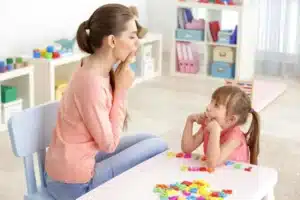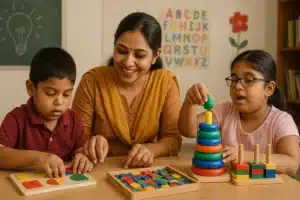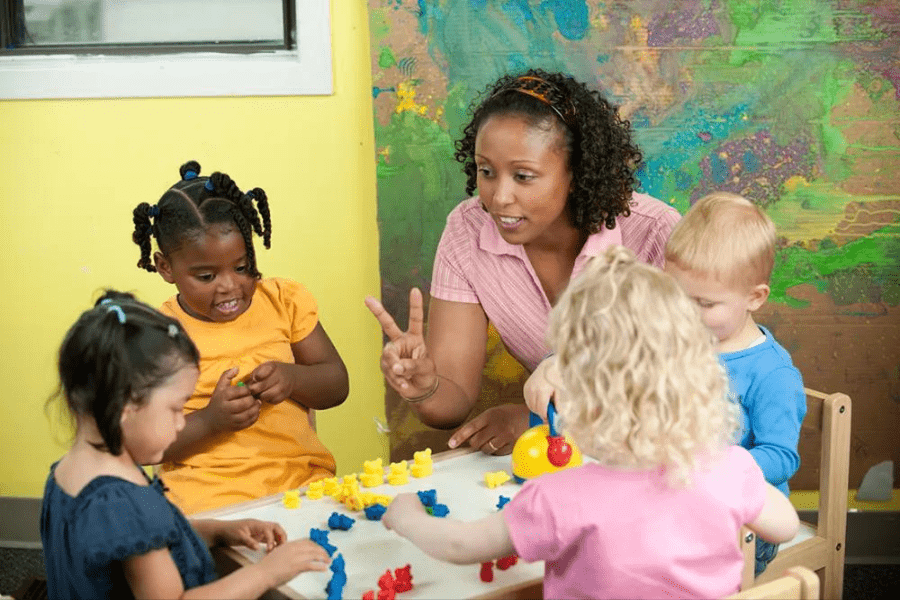
Source: goodsoil
Circle Time for Kindergarten is a structured group activity that helps children develop a sense of socializing and connecting, it is conducted at the initial part of the class. It is a great approach that enhances the listening skills of children and fosters collaborative learning. Circle Time for Kindergarten creates a positive and inclusive environment where engaging interactions take place boasting confidence among children and supporting the overall growth and development of every child in the classroom.
For more details of Kindergarten Teacher Course Call / Whatsapp on +919869546913 / +9198698966277
To download brochure of Kindergarten Teacher Course, Click Here!
What are the 5 Rules of Circle Time?
Circle Time for Kindergarten is a productive and pleasurable performed at the start of the class. The circle activity consists of 5 Rules, which makes it more interesting and meaningful.
Let’s discover what are the 5 rules of circle time:
Equal Contribution of every child
Teachers attentively listen to every of children and appreciate them for their innovative imagination.
Raise Hands to Speak
Ensuring everyone gets a chance to share their thoughts, children should raise their hands to speak.
Do Not Intrude
Teach kids to listen without interrupting others.
Take Turns
Guarantee that every child gets an impartial chance to participate by taking turns.
Allow Passing
Respect individual comfort levels by allowing children to pass if they don’t feel like speaking.
Understanding these 5 rules helps teachers to conduct a well-organized circle time activity, and ensures an interesting, comprehensive, and active learning experience for all children.
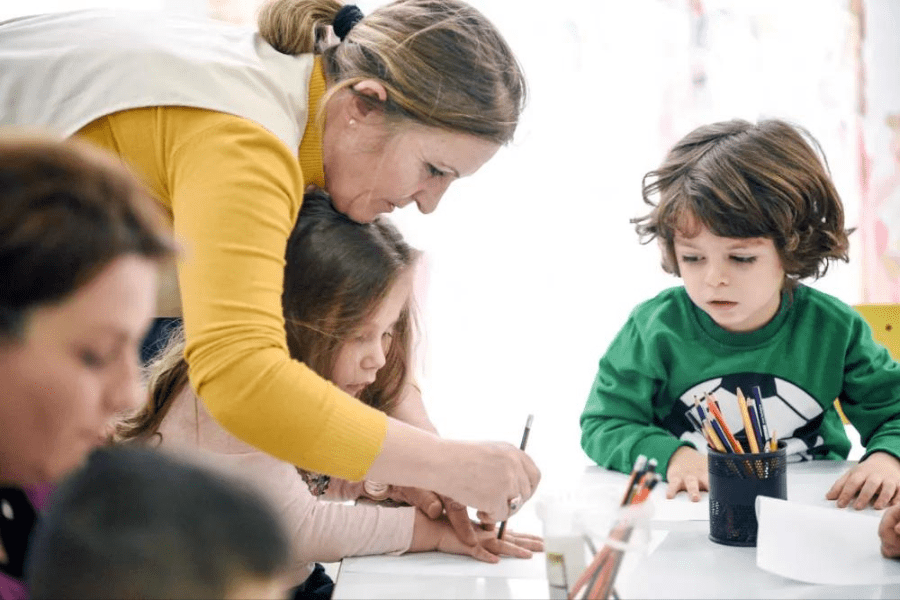
Source: unicef
What are the 5 Stages of Circle Time?
Circle Time for Kindergarten is a crucial part of the day that helps children develop essential learning skills. So, what are the 5 Stages of Circle Time?
Looking
Teach children to focus their eyes on the speaker or the activity. This skill helps them pay attention and stay engaged.
Listening
To foster better communication, understanding, and response, children are encouraged to listen attentively to what others are saying.
Speaking
Give each child a chance to speak and share their thoughts. This stage helps build confidence and improves verbal skills.
Thinking
Prompt children to think about what is being discussed or asked. Thinking makes brain neurons active and augments critical analysis, also enhances problem-solving capabilities.
Concentrating
This skill is vital to make children concentrate on the task at hand without getting distracted. It helps in the overall learning process and development of the child.
Practicing these 5 Stages of Circle Time ensures the development of strong, listening, speaking, thinking, and concentrating abilities. Circle Time for Kindergarten is an effective practice to nurture essential skills in a fun and engaging manner.
What is an Example of Circle Time Activity?
Circle Time for Kindergarten is filled with dynamic and engaging activities that make this activity enjoyable. Activities can change every day but the most loved one is singing captivating rhymes or songs that include movements, allowing children to engage their bodies before transitioning to the next activity.
Other Example of Circle Time Activity include:
- Clapping along to a beat
- Making animal noises
- Stomping feet
- Freezing when the music stops
Understanding what is an example of Circle Time activity helps in creating a dynamic and interactive environment, essential for the overall development of young learners.
What Topics to Discuss in Circle Time?
Circle Time for Kindergarten is an enriching part of the day where children engage in various activities that promote learning and social skills. So, what topics to discuss in Circle Time?
Reading Books
Storytime is a popular activity that offers significant benefits. Reading develops the cognitive imagination of children and enhances their language skills with innovative vocabulary words.
Thematic Lessons with Props
Introduce short lessons with tangible objects. For example, use a magnifying glass and a live insect to teach about insects. This hands-on approach keeps children engaged and curious.
Dramatic Play
Children learn better with practical demonstrations and experiences such as pretending the rug is a boat or visiting a grocery store. Dramatic play raises self-expression and imagination.
Interactive Hands-On Activities
Engage children with activities that involve movement and exploration. Use props to teach concepts and make story time interactive, enhancing their learning experience.
Turn-Taking and Sharing
Foster communication and social-emotional skills by having children pass toys around the circle and share stories or thoughts. This practice promotes patience and listening skills.
Understanding what topics to discuss in Circle Time ensures that Circle Time for Kindergarten is a dynamic and beneficial part of the children’s daily routine, promoting holistic development.
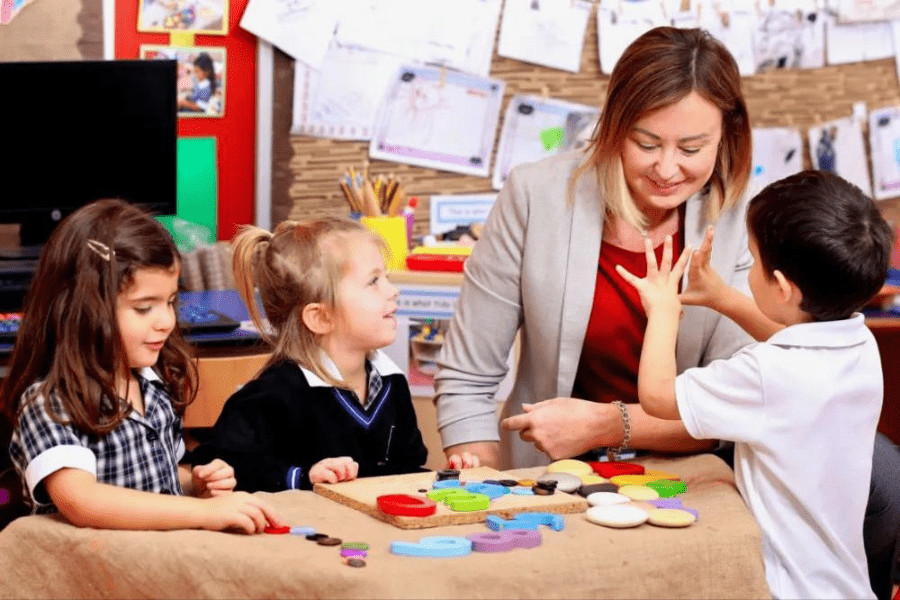
Source:brigthoncollege
Kindergarten Teaching Certificate
Kindergarten Teacher Training Course is a comprehensive program that equips aspiring educators with knowledge and the skills required to lay the foundational base of learning for young humans. Vidhyanidhi Education Society (Govt. Regd.) offers a Kindergarten Teaching Certificate that provides all-inclusive training and opens numerous job opportunities that lead to professional growth in the field of early childhood education.
Let’s explore rewarding career paths after acquiring a Kindergarten Teaching Certificate:
Head Teacher
Grab the opportunity to work as the main teacher in a kindergarten section, who leads the class and marks a meaningful impact.
Trainer
With thorough knowledge of early education individuals can choose to work as a trainer in teacher training institutes or faculty members sharing their proficiency with forthcoming educators.
Supervisor/Coordinator
Oversee educational programs and staff, by taking roles such as supervisor or coordinator in schools.
Curriculum Planner
Become a curriculum planner or developer, designing engaging and effective learning experiences for young children.
Entrepreneur
Be your boss and start a playschool setup, preschool, daycare center, activity classes, or summer camp.
The Kindergarten Teaching Certificate prepares participants for varied professional roles and also enhances their personal growth. Even mothers can opt for this program to better understand child developing stages and improve parenting skills. Vidhyanidhi Education Society’s (Govt. Regd.) Kindergarten Teacher Training Course ensures you are well-equipped to excel in these roles, making a positive impact on young learners’ lives.
By fulfilling inclusive training by Vidhyanidhi Education Society (Govt. Regd.), participants are empowered to make a significant impact and become versatile educators. Kindergarten Teaching Certificate exposes numerous career paths and qualifies individuals to contribute implicitly to the field of early childhood education.
Join Vidhyanidhi Education Society’s course and create magical Circle Times every day!
For more details of Kindergarten Teacher Course Call / Whatsapp on +919869546913 / +9198698966277
To download brochure of Kindergarten Teacher Course, Click Here!
FAQs
What is the Qualification for a Kindergarten Teacher?
The required criterion to become a kindergarten teacher is a 12th-grade of education and a Kindergarten Teaching Certificate.
Can I Become a Kindergarten Teacher after 12th?
Individuals can become kindergarten teachers after 12th grade, by pursuing a Kindergarten Teacher Training Course.
What is the Best Part of Being a Kindergarten Teacher?
The benefit of being a kindergarten teacher is to see young children grow and develop and achieve milestones in learning.

